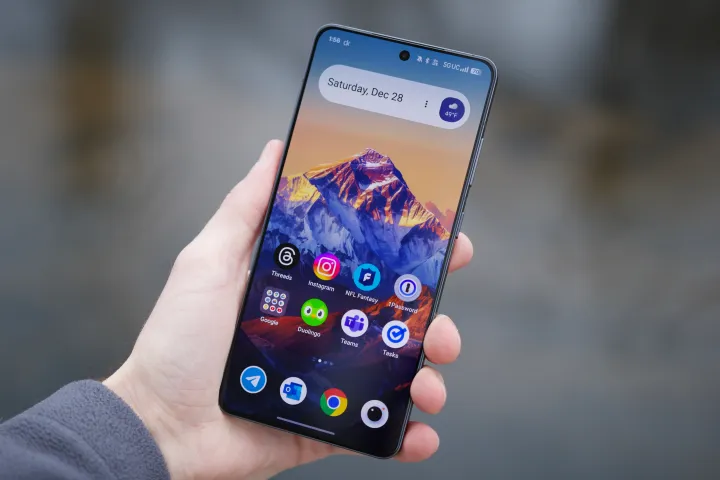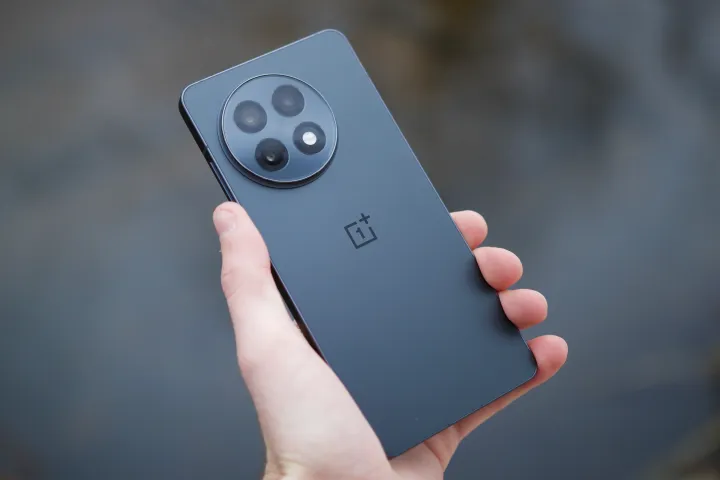Are you looking to purchase a great phone that won’t break the bank? Great! Now you just have to decide between an Android-based phone and an iPhone. Why not consider the newly released OnePlus 13R and 2023’s iPhone 15? If it seems odd to pitch a high-powered flagship against a $600 midrange phone, well, you mustn’t know much about the OnePlus 13R. Which one is right for you? Where does each phone shine? Let’s take a closer look.
OnePlus 13R versus iPhone 15: specs
| OnePlus 13R | iPhone 15 | |
| Size | 6.36 x 2.98 x 0.32 inches | 5.81 x 2.82 x 0.31 inches |
| Weight | 7.27 ounces | 6.02 ounces |
| Screen size and resolution | 6.78-inch AMOLED
2,780 x 1,264 pixels 1-120Hz adaptive refresh rate |
6.1-inch Super Retina XDR OLED
2556 x 1179 pixels at 460 pixels-per-inch 60Hz refresh rate |
| Operating system | Android 15
OxygenOS 15 |
iOS 18 |
| Storage | 256GB or 512GB | 128GB, 256GB, 512GB |
| Processor | Qualcomm Snapdragon 8 Gen 3 | Apple A16 Bionic |
| RAM | 12GB or 16GB | 6GB |
| Cameras | Rear: 50-megapixel (wide), 8MP (ultrawide), 50MP (telephoto)
Front: 16MP |
Rear: 48MP primary camera, 12MP ultrawide
Front: 12MP TrueDepth |
| Water resistance | IP65 | IP68 |
| Battery and charging | 6,000mAh
Video playback: up to 24 hours Up to 80W fast charging Up to 50% charge in 20 min |
3,349mAh
Video playback: 16 to 20 hours 20W fast charging Up to 50% charge in 30 minutes |
| Colors | Black Eclipse, Midnight Ocean, and Arctic Dawn | Blue, pink, yellow, green, black |
| Price | From $599.99 | From $699 |
| Review | OnePlus 13R | iPhone 15 |
OnePlus 13R versus iPhone 15: design and display

The OnePlus 13R and iPhone 15 have distinct design languages that cater to different user preferences. The OnePlus 13R showcases a sleek, modern Android aesthetic with a curved glass back that feels premium and enhances grip. Its prominent circular camera module adds a touch of sophistication and innovation, while the punch-hole front camera seamlessly integrates into the display, maximizing screen real estate. The device boasts a larger 6.74-inch display with a 120Hz refresh rate, delivering smoother scrolling, more fluid animations, and a more responsive gaming experience. This size and refresh rate make it ideal for multimedia consumption, offering an immersive experience for videos and games.
In contrast, the iPhone 15 retains Apple’s signature minimalist design, featuring flat edges that evoke a sense of elegance and durability. The device’s smaller 6.1-inch display is cushioned by premium materials that give it a sturdy feel. The distinctive “Dynamic Island” notch replaces the traditional notch and introduces interactive elements that enhance the user experience by displaying notifications and background activities more engagingly. The iPhone 15’s display boasts higher pixel density despite the smaller size, leading to sharper images and text. Additionally, it excels in brightness, providing vibrant colors and excellent outdoor visibility, making it a strong contender for users who often use their phones in bright sunlight. Unfortunately, the iPhone 15 is suck with an embarrassing 60Hz refresh rate.
Ultimately, the choice between these designs comes down to personal preference regarding size, aesthetics, and display features. Whether one leans towards the futuristic, larger design of the OnePlus 13R or the classic, refined look of the iPhone 15, both devices showcase their unique strengths that cater to different users in the competitive smartphone market.
Winner: OnePlus 13R
OnePlus 13R versus iPhone 15: performance

The OnePlus 13R and iPhone 15 feature older chipsets than the OnePlus 13 (with the Snapdragon 8 Elite) and iPhone 16 series (A17 Pro), respectively.
The OnePlus 13R and the iPhone 15 have different approaches to performance. The OnePlus 13R is equipped with a Snapdragon 8 Gen 3 processor and offers up to 16GB of RAM, delivering impressive performance for Android users. It efficiently handles demanding games and multitasking, while its 120Hz refresh rate display enhances the overall smoothness of the experience.
In contrast, the iPhone 15 is powered by Apple’s A16 Bionic chip, which provides fast processing speeds and outstanding graphics performance. It particularly excels in graphics-intensive tasks and augmented reality applications. Thanks to Apple’s seamless hardware and software integration, the iPhone 15 benefits from enhanced efficiency and responsiveness.
Regarding benchmarks, the Snapdragon 8 Gen 3 outperforms the A16 Bionic in CPU and gaming performance. However, the A16 Bionic leads in battery performance.
Winner: Tie
OnePlus 13R versus iPhone 15: cameras

The OnePlus 13R features a triple-camera setup on the back, consisting of a 50-megapixel primary camera, a 50MP telephoto camera with 2x optical zoom, and an 8MP ultrawide camera. We generally appreciate the performance of these cameras, though we found the 2x optical zoom somewhat lacking and noticed that the ultrawide camera has a lower resolution than is ideal. Additionally, there is a 16MP front camera.
The iPhone 15 features an improved camera system compared to the iPhone 14 from the previous year. It includes a 48MP primary camera and a 12MP ultrawide lens with a 120-degree field of view on the rear. The front has a 12MP TrueDepth camera. One notable aspect of the iPhone 15 camera is its larger sensors, which allow for 2x optical zoom even without a dedicated telephoto lens, which is quite impressive.
You’ll likely be pleased with both phones’ camera systems. However, other smartphones, such as the OnePlus 13 and the 2023 iPhone 15 Pro, which are probably the main competitors to these devices, could offer a better experience.
Winner: Tie
OnePlus 13R versus iPhone 15: battery life

The OnePlus 13R boasts a significantly larger battery capacity than the iPhone 15, featuring a 6,000mAh battery compared to the iPhone 15’s 3,349mAh. This difference results in noticeably longer usage times, especially under heavy use. In real-world tests, we found that the OnePlus 13R can last up to two days on a full charge, and with lighter usage, it can even be considered a three-day smartphone.
The OnePlus 13R also supports 55W charging speeds, allowing it to reach over 50% charge in just 15 minutes. A full charge takes just under an hour. While impressive, this is actually a downgrade on the 80W charging available on its predecessor, the OnePlus 12R.
In our initial review of the iPhone 15, we noted that it lasted just over a day during regular use before needing to be recharged. Regarding charging capabilities, the iPhone 15 can achieve a 50% charge using a 20W adapter in under 30 minutes, which falls short when compared to the charging speed of the OnePlus 13R.
Winner: OnePlus 13R
OnePlus 13R versus iPhone 15: software and support

The OnePlus 13R operates on OxygenOS, which is based on Android 15. This platform offers a high level of customization, allowing users to personalize their home screens, app icons, and even system-level functions. Overall, it provides a more open and flexible experience compared to iOS.
In contrast, the iPhone 15 runs on iOS 18, which is known for its simplicity, user-friendliness, and focus on privacy. iOS delivers a more curated experience with tighter integration between hardware and software, resulting in smooth performance and a cohesive ecosystem.
The OnePlus 13R includes several AI features such as unblur and resolution boost photo editing tools, note summarization, and Google’s Circle to Search. Unlike the iPhone 15 Pro series, the iPhone 15 does not have Apple Intelligence support. However, iPhone 15 users can still utilize third-party AI tools like Google’s Gemini.
Regarding software updates, OnePlus promises four years of Android OS updates and six years of security updates. In comparison, Apple promises at least five years of iOS updates for the iPhone 15. However, this period began with iOS 17 in 2023, meaning the guarantees will end in 2028 with the release of iOS 22.
Ultimately, the choice between the two comes down to personal preference: Android offers flexibility and customization, while iOS prioritizes ease of use and a streamlined experience. When comparing software support, the difference is minimal.
Winner: Tie
OnePlus 13R versus iPhone 15: price and availability
The OnePlus 13R is available globally, with a starting price of $600 for the 256GB model, making it an attractive option for those seeking a high-performance smartphone without breaking the bank. It features three striking colors: Black Eclipse, which offers a sleek and sophisticated look; Midnight Ocean, which adds a touch of depth with its rich blue tones; and Arctic Dawn, a refreshing light color that stands out.
In comparison, the older iPhone 15 starts at $699 for the 128GB version, which can feel limiting for users who need more storage. The iPhone 15 comes in five vibrant colors: blue, pink, yellow, green, and black, appealing to a wide range of personal styles. While the iPhone offers a strong ecosystem and brand loyalty, price-wise, the OnePlus 13R clearly reigns supreme for those on a smaller budget.
Winner: OnePlus 13R
OnePlus 13R versus iPhone 15: verdict

The OnePlus 13R and the iPhone 15 offer unique advantages tailored to different user preferences. However, the OnePlus 13R is over a year newer than the iPhone 15, significantly impacting its appeal and features. This age difference can be crucial for users looking for the latest innovations.
A more relevant comparison would be between the OnePlus 13R and the iPhone 16. By comparing these two devices, consumers can make a more informed decision based on the latest offerings from each brand.
For individuals deeply immersed in Apple’s ecosystem — utilizing services like iCloud, Apple Music, and seamless device integration between iPhones, iPads, and Macs — the iPhone 15 remains the better choice. The brand’s cohesive ecosystem enhances the user experience, providing convenience and continuity across Apple devices.
Buy the OnePlus 13R:
Buy the iPhone 15:
